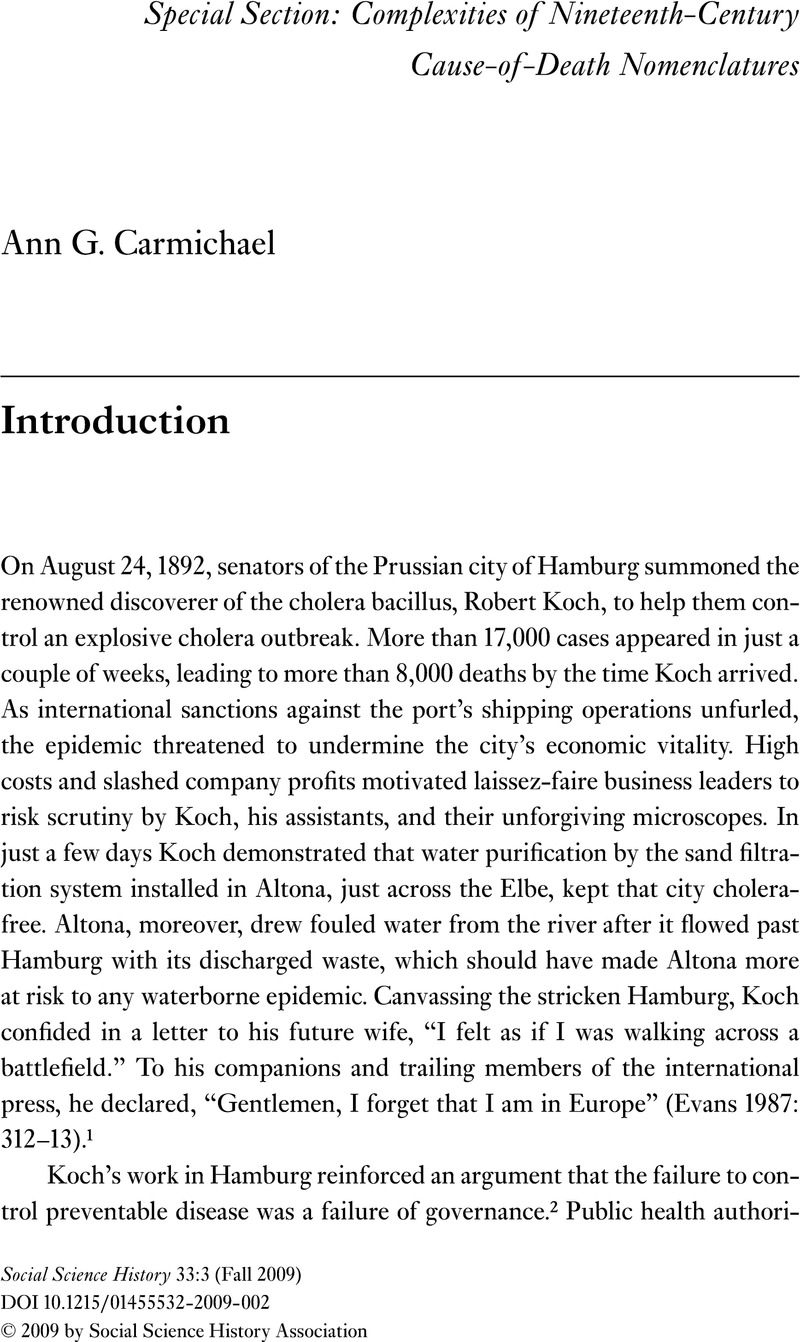No CrossRef data available.
Article contents
Abstract
An abstract is not available for this content so a preview has been provided. Please use the Get access link above for information on how to access this content.

- Type
- Special Section: Complexities of Nineteenth-Century Cause-of-Death Nomenclatures
- Information
- Copyright
- Copyright © Social Science History Association 2009
References
Alter, G. C., and Carmichael, A. G. (1996) “Studying causes of death in
the past: Problems and models.” Historical
Methods
29: 1–5.Google Scholar
Alter, G. C., and Carmichael, A. G. (1997) “Reflections on the
classification of causes of death.”
Continuity and Change
29: 169–73.Google Scholar
Alter, G. C., and Carmichael, A. G. (1999) “Classifying the dead: Towards
a history of state registration of causes of death.”
Journal of the History of Medicine and Allied Sciences
54: 1–24.Google Scholar
Anderton, D. L., and Leonard S., Hautaniemi (2004) “Grammars of death: An
analysis of nineteenth-century literal causes of death from the age of
miasmas to germ theory.” Social Science
History
28: 111–43.Google Scholar
Beemer, J. K., Anderton, D. L., and Leonard S., Hautaniemi (2005) “Sewers in the city: A case
study of individual-level mortality and public health initiatives in
Northampton, Massachusetts, at the turn of the
century.” Journal of the History of Medicine and
Allied Sciences
60: 42–72.Google Scholar
Bowker, G. C., and Star, S. L. (1999) Sorting Things Out: Classification and Its
Consequences; Inside Technology. Cambridge,
MA: MIT
Press.Google Scholar
Brock, T. D. (1988) Robert Koch: A Life in Medicine and
Bacteriology. Berlin:
Springer.Google Scholar
Brown, M. (2008) “From foetid air to filth: The
cultural transformation of British epidemiological thought, ca.
1780–1848.” Bulletin of the History of
Medicine
82: 515–44.Google Scholar
Cain, L. P., and Rotella, E. J. (2001) “Death and spending: Urban
mortality and municipal expenditure on sanitation.”
Annales de démographie historique
2001: 139–54.Google Scholar
Carter, K. C. (2003) The Rise of Causal Concepts of Disease: Case
Histories. Aldershot, U.K.:
Ashgate.Google Scholar
Desrosières, A. (1991) “Official statistics and
medicine in nineteenth-century France: The SGF as a case
study.” Social History of Medicine
4: 515–37.Google Scholar
Desrosières, A. (2002) The Politics of Large Numbers: A History of
Statistical Reasoning, trans. C. Naish. Cambridge,
MA: Harvard University
Press.Google Scholar
Dupaquier, M. (1983) “La famille Bertillon et la
naissance d’une nouvelle science sociale: La
démographie.” Annales de
démographie historique
1983: 293–311.Google Scholar
Evans, R. J. (1987) Death in Hamburg: Society and Politics in
the Cholera Years, 1830–1910.New
York: Oxford University
Press.Google Scholar
Eyler, J. M. (1979) Victorian Social Medicine: The Ideas and
Methods of William Farr. Baltimore:
Johns Hopkins University
Press.Google Scholar
Eyler, J. M. (1987) “Scarlet fever and
confinement: The Edwardian debate over isolation
hospitals.” Bulletin of the History of
Medicine
61: 1–24.Google Scholar
Gillies, D. (2007) “Review: K. Codell Carter,
‘The Rise of Causal Concepts of Disease: Case
Histories.’” British Journal for the
Philosophy of Science
58: 365–78.Google Scholar
Gruenberg, E. M. (2005 [1977]) “The failures of
success.” Milbank Quarterly
83: 779–800.Google Scholar
Haines, M. R., and Kintner, H. J. (2000) “The mortality transition in
Germany, 1860–1935.” Historical
Methods
33: 83–104.Google Scholar
International Statistical Institute (1930)
Nomenclatures internationales des maladies. 4th sess., Paris,
whqlibdoc.who.int/hist/nomenclatures/stat1929.pdf.Google Scholar
Lévy-Vroelant, C. (1999) “Le diagnostic
d’insalubrité et ses conséquences sur la ville Paris,
1894–1960.” Population
54: 707–44.Google Scholar
Lewes, F. M. M. (1988) “Dr. Marc
d’Espine’s statistical nosology.”
Medical History
32: 301–13.Google Scholar
Meslé, F. (2003) “Causes of
death,” in Demeny, P. and McNicoll, G. (eds.) Encyclopedia of Population. New
York: Macmillan:
119–22.Google Scholar
Meslé, F., and Vallin, J.(1996) “Reconstructing long-term
series of causes of death.” Historical
Methods
29: 72–87.Google Scholar
Mitchell, A. (1990) “An inexact science: The
statistics of tuberculosis in late nineteenth-century
France.” Social History of Medicine
3: 387–403.Google Scholar
Mooney, G. (2007) “Infectious diseases and
epidemiologic transition in Victorian Britain?
Definitely.” Social History of Medicine
20: 595–606.Google Scholar
Omran, A. R. (2005 [1971]) “The epidemiologic
transition: A theory of the epidemiology of population
change.” Milbank Quarterly
83: 731–57.Google Scholar
Ramsey, M. (1994) “Public health in
France,” in Porter, D. (ed.) The History of Public Health and the Modern
State. Amsterdam:
Rodopi:
45–118.Google Scholar
Reher, D. S. (1999) “Back to the basics: Mortality
and fertility interactions during the demographic
transition.” Continuity and Change
14: 9–31.Google Scholar
Reher, D. S. (2004) “The demographic transition
revisited as a global process.” Population,
Space, and Place
10: 19–41.Google Scholar
Rusnock, A. (2002) Vital Accounts: Quantifying Health and
Population in Eighteenth-Century England and France.
New York: Cambridge
University Press.Google Scholar
Rusnock, A., ed. (1996) The Correspondence of James Jurin
(1684–1750): Physician and Secretary for the Royal Society.
Amsterdam:
Rodopi.Google Scholar
Smith, R. M. (1993) “Demography and
medicine,” in Bynum, W. F. and Porter, R. (eds.) Companion Encyclopedia of the History of
Medicine. London:
Routledge:
1663–92.Google Scholar
Szreter, S. (1997) “Economic growth, disruption,
deprivation, disease, and death: On the importance of the politics of public
health development.” Population and
Development Review
23: 693–728.Google Scholar
U.S. Bureau of the Census (1911) Manual of
the International List of Causes of Death, Based on the Second Decennial
Revision by the International Commission, Paris, July 1 to 3, 1909.
Washington, DC: U.S.
Government Printing Office.Google Scholar
Wilbur, C. L. (1902) Manual of International Classification of
Causes of Death: Adopted by the United States Census Office for the
Compilation of Mortality Statistics for Use Beginning with the Year
1900. Washington, DC:
U.S. Government Printing
Office.Google Scholar
Woods, R. (2007) “Medical and demographic
history: Inseparable?” Social History of
Medicine
20: 483–503.Google Scholar




